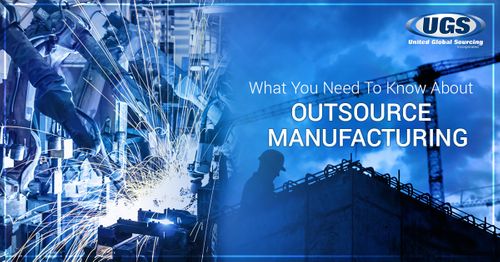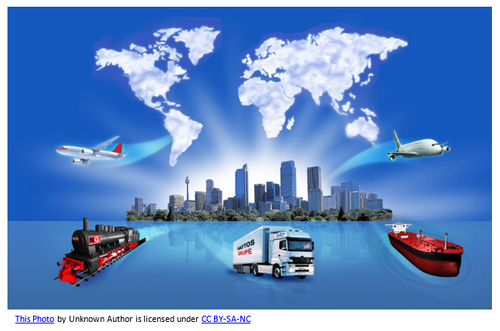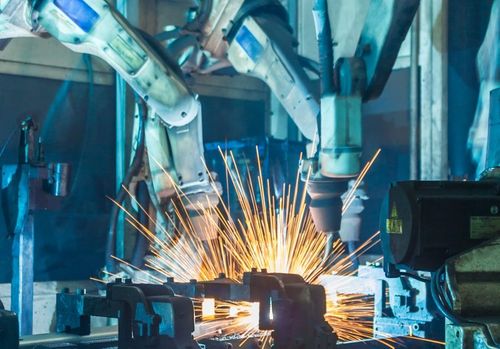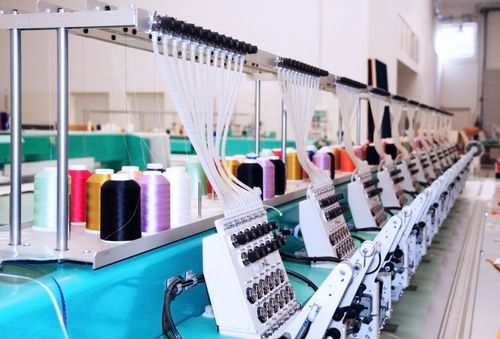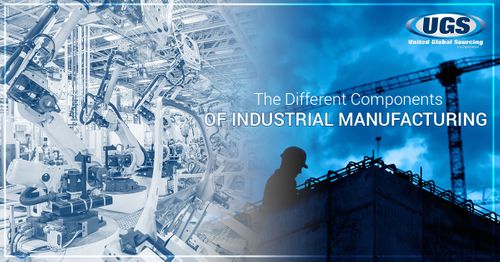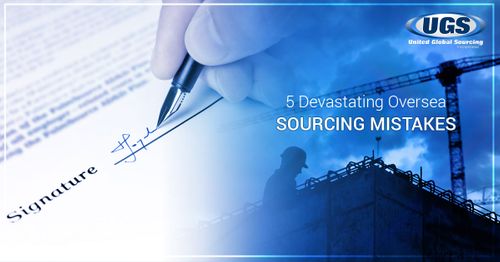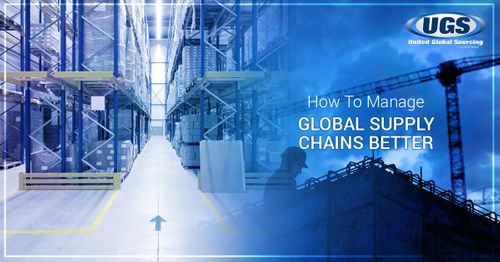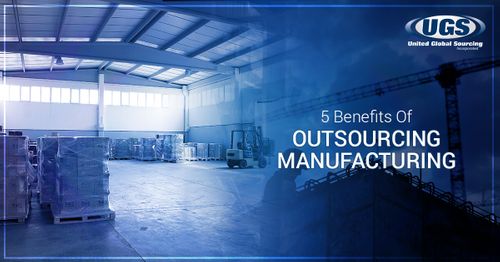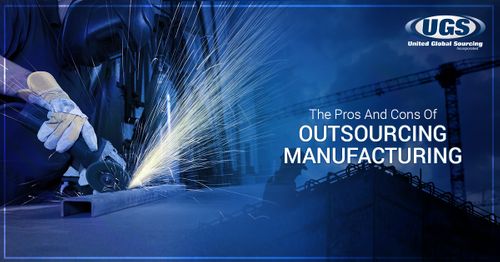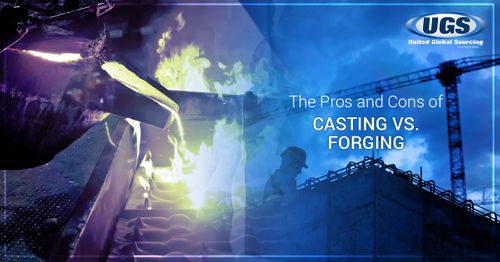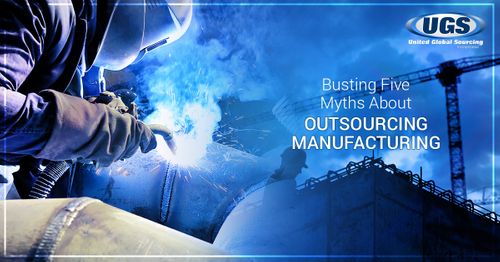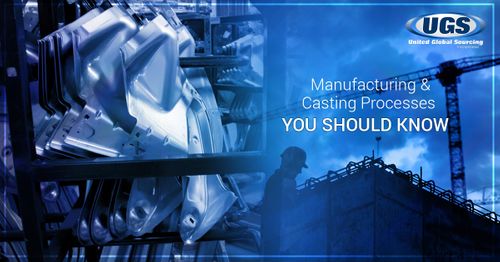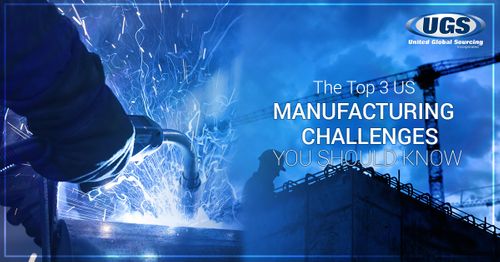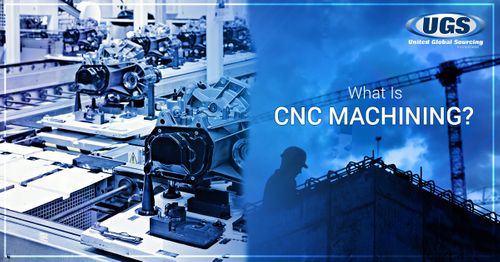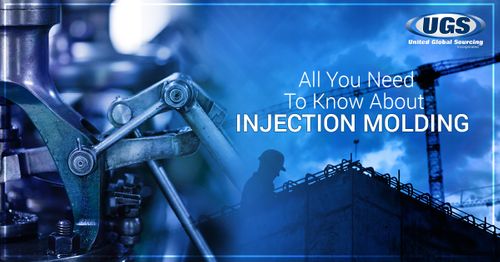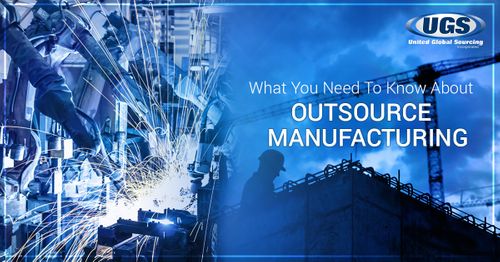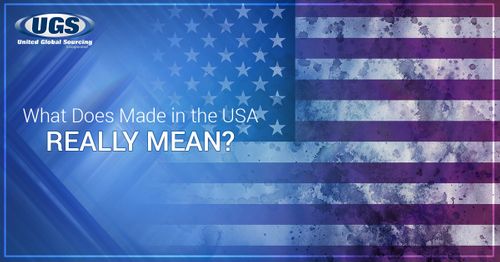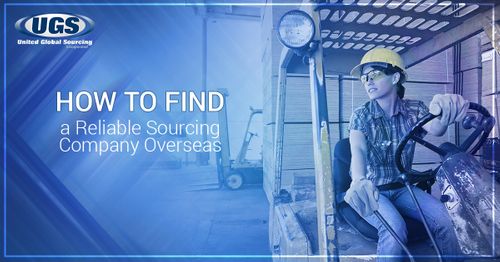Blog
Recent Updates
Case Study: Commercial Beer Taps
The parts that we make for commercial beer dispensing systems keep the game flowing! Whether in a stadium, a sports bar or at events, UGS manufactures commercial components and systems that conform to the tightest tolerances and exceed customer expectations. Contact us today to learn how we can help your company deliver great results to your customers with superb quality at a lower cost.
moreRecap of the National Hardware Show
This year, 2019, marked the 74th year of the National Hardware Show®, held May 7th-9th at the Las Vegas Convention Center. This annual show featured products and services from the home improvement marketplace. Over 2700 exhibitors from over 32 countries launched over 1000 brand new products during the 2019 National Hardware Show, with an estimated attendance of 19,000. In years past, the show had its start in New York, following the post-World War II housing boom. It migrated to the Midwest, settling in Chicago during the 1970's and eventually moved farther West to its current location in Las Vegas, NV.
The National Hardware Show has become the gathering place for big buyers to find the latest and greatest products they’d like to see offered at the nation’s leading hardware retailers. The show’s goal is to promote hardware businesses in all sectors worldwide. Additionally, the show provides opportunities for smaller companies to present their inventions to buyers and interested parties they normally wouldn’t have the opportunity with which to connect.
moreIs Turnkey Manufacturing Right for Your Business?
After spending months, if not years, in the concept and design phase of your product’s life cycle, you’ve now found yourself upon the doorstep of the manufacturing stage. Obviously, this part of getting your product made is arguably the most critical and time-intensive. Trying to manage several disparate companies to handle each part of the production process can turn out to be cumbersome and costly. Here’s where turnkey manufacturing can come into play. To get started, let’s define the phrase turnkey manufacturing.
Turnkey manufacturing means having 100% of the manufacturing process handled by one entity. In this scenario, one company manages and streamlines all pieces and parts of the manufacturing process from start to finish. This includes beginning at the initial concept and design and continuing all the way to the packaging and shipping of your final manufactured product. Next, we’ll explore some of the many advantages of working with a unified source for your manufacturing needs.
One major perk of implementing turnkey manufacturing in your organization is the cost-savings it generates. And those cost-savings start immediately, through receiving the most competitive pricing via an established network of factories and suppliers. Costs are especially reduced for smaller companies since with this model, they can avoid the added cost that comes with trial and error. Turnkey manufacturers can also reduce your costs through centralized billing and discounts for services like design, logistics, and so on.
moreKey Facets of the Outsourced Manufacturing Process
Figuring out how to turn your original idea into an actual product can seem overwhelming. “Where should I begin?” you may be asking yourself. Finding a skilled partner in outsourced manufacturing is an excellent place to start. After you secure that partnership, the outsourcing company can help turn your idea into reality by following these key facets in the outsourced manufacturing process.
It all starts with an idea – an idea that came to you in a dream, a realized need, or through the course of a product life cycle. Whatever the specific situation, you are ready to turn that idea into a realistic conceptualization of your product. At this point in the manufacturing process, your outsourcing partner will use their knowledge of materials and manufacturing techniques to determine the practicality of getting your product made. And as part of the decision to move forward with the commitment to making your product a reality, your business must also decide whether it is marketable and will produce a profit. If the answer is yes, then it is time to move on to the design stage in the manufacturing process.
moreInnovations in Precision Machining in 2019
Between 2015 and 2024, the CNC machining industry is expected to almost double in value from around $53 Billion to over $93 Billion globally. Advantages of using precision machining equipment like CNC machines – computerized machine tools like lathes, mills, routers, and grinders - results in less human error while increasing overall production efficiency. Precision machining is a common term used in various types of manufacturing. It’s defined as a way or process to remove excess material from a product, while keeping the work-in-progress within acceptable tolerances. Next, we examine some innovations in precision machining that continue to drive its adoption.
Using Additive Manufacturing for Prototyping
Traditional CNC machining calls for a block of material to be cut away and precision-machined to meet its proper specifications and tolerances. On the other hand, additive manufacturing a.k.a. 3D printing, combines materials to build a finished project. While precision machining is still the preferred machining choice for mass-manufactured parts, additive manufacturing can be implemented at a lower cost for prototyping and sampling. This is due to the lowering costs of 3D printing and reduction in material waste.
more3 Methods to Streamline Global Logistics
The management of a company’s global logistics can seem daunting at the outset; especially considering the recent changes in tariff increases. Figuring out which HTS codes cover which products can be a time-consuming task. And staying on top of the specific requirements for multiple companies - across a multitude of logistics needs: air; ground; shipping - requires careful coordination of international logistical services. Following are suggestions for utilizing streamlined global logistics and how to optimize their functionality.
- Harnessing the Power of Consolidation
There are myriad benefits to consolidating your company’s global logistics efforts. For starters, standardized procedures can be implemented to restructure and better organize the paper trail concerning all shipping documents involved in the delivery process. Implementing software analytics can assist carriers in optimizing routes and pickups. As a result, processing payments becomes a simpler process through consolidation, with fewer carriers amounting to fewer payments and a more efficient accounting processing.
- Centralized Management of Delivery Vendors
Top Trends in Industrial Manufacturing
According to IDC, by 2021, 50% of the Global 2000 companies will see most of their business depend upon the ability to create digitally enhanced products, services, and experiences. In response to these changes, there are various trends emerging and expanding as we get farther into 2019. These trends include changes in technology as well as the way in which products are manufactured and assembled. Let’s examine some of the tendencies that are evolving in the area of industrial manufacturing.
Technology Enhancements to Equipment
Many companies continue to move their data and processing functions to the cloud in droves; however, this is not always the best solution for every application. For industrial manufacturing, Edge computing is more often used for speed of data collection and analysis. With Edge computing, dedicated on-site resources are used on the shop floor instead of through remote servers. Doing so significantly increases the rate and amount of data manufacturers can process in real-time.
moreHow to get your Prototype Made
Suddenly, the idea strikes you like a lightning bolt – waking you out of a sound sleep. Perhaps it was a recurring dream about an innovative new product, or just a persistent feeling there is a large need for the product you want to invent and get to market. However the thought came to you, now you’re ready to see it put to paper in a realistic design and 3-dimensional form.
So how do you go about seeing your vision for a new product take form and become a marketable product? You’ve got to get it made as a prototype for starters. And what are the necessary steps that must be taken to get you started in the prototyping process?
more4 Trends Impacting Plastic Injection Molding Makers in 2019
The Plastic Injection Molding Market has been continually evolving and expanding in recent years. And according to Global Market Insights, plastic injection molding has become one of the most commonly-used plastic formation techniques utilized across a variety of industrial applications today. Industrial sectors in automotive, consumer goods, electronics, general construction, packaging, medical and more, are all benefiting from the emerging trends in plastic injection molding manufacturing and showing steady growth. In fact, the global injection molded plastics market is expected to reach a whopping $162 billion by 2020.
From alliedmarketresearch.com:
moreCut and Sew: Which Factory is Best for Manufacturing your Products?
Cut and Sew: Which Factory is Best for Manufacturing your Products?
Maybe you’re a cutting-edge designer, ready to show the world your creative talent. Perhaps you have a great mass merchandising idea that you are ready to produce. Whatever the situation regarding your cut and sew product, when you’re ready to manufacture it, you’ll need to find the best factory for the job. ‘That’s easy’, you might be thinking. ‘I just need to find the lowest-cost manufacturer.’ But in reality, there are myriad other considerations in the production process.
First off, you’ll have to decide what role the factory will take in making your products. Will they be managing the entire process, or will they be just handling a portion of it? Other questions to ask concerning the factory’s role include:
- Will the factory create a sample based on your sketches or designs?
- Will you provide the materials for the item(s) you want made or will that be the responsibility of the factory to source?
- Will the entire item(s) be assembled at the factory or will any pre-processing be performed elsewhere?
- Do your products need to be hand-made or can some or all of the process be automated?
- Where will the items be sent upon completion: a 3PL, a dedicated warehouse or direct to retailers?
- Product labeling considerations for Prop 65
The Different Components of Industrial Manufacturing
The industrial manufacturing industry spreads far and wide. From automobile parts to sporting goods, this industry is responsible for the fabrication of products intended mostly for industrial use. There are a variety of manufacturing processes in this field. Let’s take a look at some of the most common below.
moreCan Outsourcing Sub-Assembly Lower Production Costs?
Most original equipment manufacturers (OEMs) choose to outsource their sub-assembly needs to lower production costs, but there are many other reasons to do so. During the sub-assembly process, companies will hire an outside manufacturer to build smaller parts that are used with OEM products. This can save them a significant amount of time and money in the long-run and is a great way to streamline and improve current operations. The main benefits of outsourcing sub-assembly include:
- Cost savings
- Improved quality
- Volume flexibility
Let’s take a closer look at each of these benefits below.
more5 Devastating Oversea Sourcing Mistakes
The global market is ever-expanding. More businesses are sourcing overseas for a variety of reasons, competitive pricing, lower manufacturing costs, and proximity to market specific customers. However, with great opportunity comes great risk. Whether you’re a budding startup founder or established CEO, both looking to penetrate a new market, it’s best to know where some of the most devastating stumbling blocks are located before you run into them yourself.
In this post, we share five mistakes business owners make sourcing overseas that they need to avoid. A successful business relies heavily on its ability to establish and continuously optimize its supply chain, resulting in customer satisfaction. If this is not a priority, the business will suffer. Part of this optimization is understanding customers, governments, countries, and more when sourcing globally.
moreWant Business Success? Optimize Your Supply Chain!
The performance of your business is undeniably linked to the success of your supply chain. As an established CEO expanding into new regions or a startup founder looking to takeover certain markets, the optimization of your supply chain could mean the difference between seven percent and 20 percent profit margins. At United Global Sourcing, we’ve seen some pretty large profit margins due to supply chain optimization, but a growth of even 10 percent can help expand companies exponentially. According to the Logistics Bureau, 79 percent of companies that optimize their supply chains reported above-average overall growth.
In most cases, supply chains are not very efficient. The ever-evolving market and supply chain participants keep the industry in a constant state of chaos that has yet to be tamed. Factors like countries, governments, and customers all affect the supply chain in a way that makes it near impossible to be successful. Supply chain costs tend to sink businesses before they ever see a profit. Nonetheless, a diligent, smart sourcing company can find success.
moreDeveloping A Supply Chain Strategy? Here Are 5 Tips!
Do you know if your supply chain is helping or hurting your business goals? If you think it’s the latter, it’s time to review your business goals, your supply chain strategy, and how they fit together. The biggest mistakes any supply chain manager makes is keeping the chain and the businesses goals separate. A supply chain is a catalyst for the results you want to get in your business, so it should be included in the business strategy. With that being said, here are five tips on how you can develop a supply chain strategy.
moreThe Benefits Of Supply Chain Management Collaboration
A successful global supply chain ultimately comes down to two things: quality and communication. Without one or the other, the chain will operate, but not at optimal levels. If the chain is missing both traits, it will eventually crumble underneath impossible to meet deadlines and ever-evolving end-customer needs.
At United Global Sourcing, we do more than connect you with a manufacturer or supplier. We establish a system that communicates with you on a 24-hour cycle, so you always know what’s going on.
In this post, we’re going to discuss the benefits of supply chain collaboration. It may seem counterintuitive in a supply chain to be transparent, but this is the secret the successful experts in the industry aren’t sharing. You may be concerned with fraud, waste, or costly mistakes. At UGS, we understand your concern. However, the only way to mitigate all three of those constants in supply chain management is to create candid communication and quality work within the chain. Transparency is the key to finding ways to tighten up a supply chain, improve processes, and increase profits.
more10 Supply Chain Secrets Experts Won’t Share
Do you want to improve your supply chain? Would you like to increase your profitability? At United Global Sourcing, our mission is to deliver you the best supply chain participants to grow your business and increase profitability. It’s no wonder why the supply chain industry is growing so fast. According to a report, the supply chain industry was worth about eight-trillion dollars in 2016, and it’s said to surpass $15 trillion in 2023.
The global market is constantly expanding. More businesses are joining the world stage. Surprisingly, it’s not saturating the market; it’s giving it more depth. Supply chains are extending in length, and the expectations of customers are ever-evolving. If you want to stay ahead of your competition, you need to know the 10 secrets to improve your supply chains the experts in the industry aren’t sharing.
more7 Dangerous Pitfalls In Supply Chain Management
The oversight and expertise needed for supply chain management is invaluable. The ability to plan for the worst and solve problems before they occur is a must. Furthermore, those in global supply chain management like United Global Sourcing leverage the available business tools and technologies to get ahead of the fast-paced industry. The success of a supply chain manager frequently relies on not what goes wrong, but how one handles the problems. In many cases, experts in the industry solve issues before they ever become a problem. These experts establish systems to better handle the ever-evolving supply chains they manage on a daily basis. In this post, we will share seven dangerous pitfalls every supply chain manager needs to be aware of, so they can better prepare their solution when things do go wrong–inevitably, they will.
moreHow To Manage Global Supply Chains Better
The global market is ever expanding. So is the length and complexity of global supply chains. The effort to meet the needs of the market are putting more stress on supply chains and their managers to perform consistently and efficiently. With so much pressure, the temptation to cut corners is ever increasing. Global supply chain management, however, must hold steadfast and do the right thing. Even though global sourcing predated the internet, as did manufacturing, transporting, and distributing, the industry is still in an ever-evolving state. That’s why it’s imperative, as a supply chain manager, to always be searching for ways to improve or enhance supply chain effectiveness and efficiency. Not only do you want to keep the end-customer satisfied, but you also want to find ways to increase profits.
more4 Barriers to Adopting Blockchain in Supply Chains
At United Global Sourcing, we’re expert communicators and value honesty over anything else. We want you to feel comfortable working with us and trust that we will deliver on our promises. With that being said, we’re digging into blockchain, the technology that’s taken the digital world by storm. It started being used with Bitcoin, but its protocol is now being used across various industries. Experts in the field are saying that blockchain is the best innovation since the internet. At UGS, we would have to agree. The technology is a great way to track, record, and confirm transactions at every stage of a supply chain. At the end of the day, blockchain may seem too good to be true. That’s why, in this post, we want to share four barriers the supply chain industry must break down to adopt the technology.
moreWhat Companies Do Overseas Manufacturing?
Did you know that some of the best well-known brands and companies send their manufacturing needs overseas? Thousands of companies choose to outsource their manufacturing because it gives them more time to focus on other facets of their business. With China being the primary source of overseas manufacturing, you may be surprised to learn which companies seek a little help overseas.
more4 Potential Blockchain Applications in Supply Chains
Blockchain has been the buzzword for the last couple of years and rightfully so. It was originally used for Bitcoin. The technology allows for people to know who owns what and when. It’s an indelible ledger, which makes for complete transparence and 100 percent accountability. What’s more, the blockchain technology protocol isn’t limited to currency, as it was originally intended. The blockchain protocol is being used across various industries in a variety of ways. It’s tightening up systems and building more trust in relationships. The exciting part about blockchain is that it will change global supply chain management.
No longer do participants involved in supply chains have to triple check their system. Blockchain will make the transactions from manufacturer to customer transparent and secure, allowing supply management to spend time optimizing their system instead of following up on a shipment unaccounted for somewhere in their chain.
more6 Ways Blockchain Will Revolutionize Global Supply Chains
As the global market expands, the need for effective and efficient supply chains increases. Two of the largest barriers to improving global supply chains are transparency and communication. Transparency allows for supply chain managers to better operate their chains. Communication tightens up supply chain production, shipping, and fulfillment times. These two barriers have always plagued supply chains, but there is a solution.
Blockchain technology was first utilized with Bitcoin. The technology is a success, and more businesses in all industries are making it a focus. They want to understand the technology, leverage it, and evolve their business to include it. This will lead to overall growth which helps improve the global economy.
From a 10,000 foot level, blockchain has huge potential to improve nearly every industry. More specifically, blockchain has the ability to revolutionize global supply chains, making management of said supply chains much easier.
moreWhy United Global Sourcing Is Excited About Blockchain
Do you think Blockchain will change the internet? At United Global Sourcing, we think blockchain will do more than change the internet; it will transform global supply chain management entirely, and we’re excited to say that. Here’s why: Blockchain allows businesses to more securely and transparently manage a wide range of transactions. What does this mean for supply chain management? Quite a few experts in the field say that blockchain is the next best invention since the internet, and we at United Global Sourcing believe the technology will evolve supply chains around the globe.
moreHow To Find The Best Outsourcing Manufacturer
It’s time you outsource your manufacturing and fabrication needs. Not only will you save money, but you will also remove the responsibility of making sure manufacturing is running properly—it will be someone else’s headache. There are a number of benefits, including growth, flexibility, and quality. When it comes to choosing a sourcing company for your products, it can get a little overwhelming. There are hundreds of companies to choose from, so how do you find the best one?
In this post, we’ll share some general advice on how to identify and qualify a sourcing company for your company’s manufacturing needs. Ready to discuss your outsourcing needs? Give United Global Sourcing a call today to get a FREE estimate. Otherwise, continue reading to learn more.
moreFour Outsourced Manufacturing Challenges
Running a business is challenging. When you decide to outsource manufacturing and/or fabrication, you will encounter new challenges. At United Global Sourcing, we want to help identify the most common challenges and then give you some solutions to better serve your business. Outsourcing can be a daunting decision. The transition, implementation, and follow-through stops business owners in their tracks. We understand! But if you want to grow your business utilizing outsourcing, contact us today!
In this post, we’ll share four challenges businesses have transitioning into outsourcing their manufacturing or fabrication needs. We’ll also share some general solutions to consider to make the transition easier.
moreFive Benefits To Outsourcing Manufacturing
When it comes to manufacturing and fabrication, United Global Sourcing strives to find the best for its clients. We offer a list of fully vetted, top-caliber factories for you to leverage to lower costs, increase sales, and improve fulfillment. Our commitment to 24-hour communication, unlike most of the industry, is what sets us apart from our competitors. We understand you’re looking for the best outsourced manufacturing for your automotive parts, sporting goods, or cut and sew products.
In this post, we’ll share the five benefits of outsourcing manufacturing. Are you ready to get started? Contact United Global Sourcing today! Otherwise, continue reading this post to to learn about the benefits.
moreThe Pros And Cons Of Outsourcing Manufacturing
Are you looking for a way to decrease expenses to free up capital for growth? It can be tough to decide between labor costs or outsourcing costs. On one hand, you can control and manage the labor, and on the other hand, you have to trust the outsourced manufacturing or fabrication is taken care of appropriately. But that’s why you went into business. You want to make an impact on the world and get paid to do it. Decisions like these aren’t something you learn through traditional education. You have to do them on your own, learning as you go.
At United Global Sourcing, we understand if you’re contemplating the idea of outsourcing manufacturing to focus more on your core competency or to simply free up some cash flow to grow your business. Our advice? Outsource. It will save you time and money, offering a peace of mind you’ve not known since you’ve gone into business.
In this post, we share the top pros and cons to outsourcing manufacturing and fabrication. We want you to know exactly what you’re getting into when you decide to outsource. What’s more, United Global Sourcing is here to help you make the most out of outsourcing. We rely on our expert communication to serve you and your company’s needs. Contact us today to learn more. Otherwise, read this post to gain some insight into outsourcing.
moreWant To Outsource Manufacturing? Don’t Risk These Four Things!
The benefits of outsourcing manufacturing heavily outweigh the disadvantages. So why doesn’t every business do it immediately? Fear, cost, quality, and transition issues all cloud the horizon for those looking to outsource internationally. But it doesn’t have to stop your business growth in its tracks. As long as you have brand, production, and quality standards, the world will open up to you and help you grow. All it takes is one phone call to Unite Global Sourcing.
At UGS, we take significant risk away from outsourcing. Our vetted lists and longstanding professional relationships with manufacturing and fabrication factroers all over the make us the premiere sourcing company to do business with. When you choose us, you get more than a connection to a manufacturer. We provide 24-hour communication processes that ensure your product, component, or otherwise is taken care of from start to finish. And it all starts with your expectations as a business owner in a global market.
In this post, we share the top four risk factors you must mitigate when outsourcing to actually be able to take advantage of it. Thankfully, UGS does this for you, so you can keep working on your business instead of in it.
moreThe Pros and Cons of Casting vs. Forging
At United Global Sourcing, we’ve got all of your manufacturing needs covered.
If you’re looking to outsource manufacturing in your business, you’ve come to the right place. We’re United Global Sourcing (UGS), and we have what it takes to meet all of your manufacturing needs. Different items require different manufacturing methods, and here at UGS, we do it all. Today, we’re going to be breaking down two very different techniques — forging and casting — that accomplish the same thing, which is molding metal into the necessary shape and size.
moreThe Importance Of The Right Packaging
You undoubtedly recognize the incredible importance of a high-quality product. It is why you will settle for nothing but the best when it comes to outsourcing your manufacturing. However, at United Global Sourcing, we don’t believe the focus on detail should stop there. We work with our clients to make sure that their product is wrapped in success through the proper packaging.
Did you know that more than half of all purchase decisions are made in-store? That means that the look, feel, and branding of your packaging has an incredibly large influence upon the final consumer purchase behavior. The right packaging can lead to success and the wrong packaging can spell disaster. Read on to learn more about the importance of packaging and find out how we can help you succeed in this area of production.
moreConduct A SWOT Assessment To Improve Your Supply Chain
When it comes to operating a supply chain, there are a myriad of moving pieces and a large number of hiccups that can occur. Your goal is to ensure that your manufacturing process implements smoothly into the rest of your business operations. In order to make the best of outsourcing your manufacturing, it is important to take the time to conduct a SWOT (Strengths, Weaknesses, Opportunities, and Threats) assessment. This can help you to minimize waste and maximize profits, all while ensuring quality in your products.
If you are considering outsourcing your manufacturing and need help conducting an assessment of your supply chain strategy, please reach out to our team. We have the industry experience and the proven relationships needed to help you find the perfect global outsourcing solution for your unique needs. Read on to learn more about our use of SWOT assessments for the clients we work with.
moreBusting Five Myths About Outsourcing Manufacturing
When it comes to your manufacturing process, your goal is undoubtedly to cut costs, improve your timeline, and retain quality. For many companies, the thought of outsourcing their manufacturing is pushed aside due to a variety of myths surrounding this version of manufacturing. However, if you want to achieve all these goals, outsourcing your manufacturing could actually be the key you are looking for. Before you write off outsourced manufacturing and stick to in-house work, consider these myth-busting facts.
If at any point in the process you want to learn more about the specifics of outsourcing your manufacturing process, please reach out to us at United Global Sourcing. We are proud to provide high-quality manufacturing solutions for our clients. We will take the time to ensure you are comfortable with the choice and that you never fall prey to the following issues.
moreThe Importance Of Sampling In The Manufacturing Process
When it comes to outsourcing your manufacturing, the benefits are plentiful. However, you might also be faced with concerns about how you will ensure the quality you need from your outsourced manufacturing. There are a myriad of ways we help our clients with quality control and one of the methods we employ is sampling.
Sampling is an important aspect of the manufacturing process and will help safeguard your business from any unpleasant surprises when your products arrive. You want your final product to meet your exact specifications, which is why sampling is a critical component of proper manufacturing processes.
The following are the reasons we opt for the implementation of sampling with our clients.
moreFind The Best Factory To Manufacture Your Product With These Tips
If you have an invention for a product, the process from idea to production can be extremely complicated and complex. In addition to finding the best factory to manufacture your product, you’ll need to spend some time researching and planning the design of your invention. One of the biggest challenges of product manufacturing is finding the perfect factory to bring your idea to life. You’ll need to do some digging to find one that fits your unique needs and budget, and in this article, we’re going to guide you through the process of finding a manufacturer to work with.
At United Global Sourcing, we’re proud to offer our small and large business customers turn key solutions for their manufacturing and fabrication needs. Whether you need help finding an industrial manufacturing company that offers precision casting, or you’re looking for a factory that can help you create a prototype of your idea, we can help. When you work with our team of professionals, you can always rest assured that we put communication and quality first. Unlike other companies who offer to connect you to a manufacturer and then suddenly disappear, we offer our customers a 24-hour communication cycle to catch any issues quickly and efficiently. If you’re interested in learning more about our services, contact our team or get a free quote online.
moreManufacturing & Casting Processes You Should Know
When a manufacturing company begins the production of a new product, they have a choice as to what kind of manufacturing process they’d like to use. Oftentimes, the process that is chosen will depend on the facility, staff, and the various information systems that are available. Converting raw materials into marketable and saleable products is the backbone of our industrialized nation, so it’s important to understand the differences between the various manufacturing processes that are available. In this blog, we’ll take a closer look at the casting process, and the various forms that are available.
If you’re looking for an industrial manufacturer to assist you with with creating a consumer product or idea, United Global Sourcing can help. Unlike most companies who will simply connect you with a manufacturer, only to disappear down the line, we maintain constant and frequent communication with all of our clients. When you work with our team, we’ll maintain a 24-hour communication cycle with you, that allows us to quickly and efficiently identify issues early on in the assembly process. We can help you find the best industrial manufacturing company for your needs and budget. Contact our team today or get a free quote online.
moreShould I Outsource My Manufacturing?
Whether your company produces sporting goods, household products, or automotive accessories, determining how and where to complete manufacturing operations is critical to the success of your business. If you haven’t considered outsourcing already, we strongly advise you to do so. When you outsource your manufacturing and fabrication needs, you’ll likely end up with a reduce in labor costs, among other benefits.
At United Global Sourcing, we’re proud to provide turnkey solutions for your manufacturing and fabrication needs. We understand how challenging it can be to bring an idea or product to life, which is why we also specialize in various areas of supply chain management. We can help you find the best overseas manufacturing company for your needs and budget, and we always keep communication at the forefront of our relationships. Unlike other companies who will simply connect you with a manufacturer and leave you out to dry, we take pride in providing our customers with a 24-hour communication cycle. This helps us to quickly and efficiently identify any issues in the early assembly and production process. From product concept to design and production, we can help you navigate the murky waters of manufacturing. Call us today or get a free quote online!
morePrototyping 101
When you have a clever or unique idea for an invention, it’s important to process a patent application as soon as possible. In 2015, the U.S. Patent and Trademark Office processed more than 629,000 patent applications! On average, only 55% of the applications submitted received a patent. A great way to improve your odds of getting a patent granted is to build a prototype of your idea or product. While the patent and trademark office does not require applicants to submit their prototype with their application, it can serve as a serious demonstration that your invention has been well thought out, which can merit your idea’s consideration.
If you’re unfamiliar with the prototyping process, there’s no need to worry. In this blog post, we’re going to discuss everything you need to know about prototyping, as well as some tips you should consider moving forward with your idea or invention.
If you have a unique idea for a product and you’re ready to bring that vision to reality, contact United Global Sourcing today. We offer a variety of supply chain management services and we can help you find the best manufacturing or fabrication company for your needs, timeline, and budget. We’ll walk you through everything from the product concept to design and packaging, so you can feel confident about the product you’re bringing to life. If you’re interested in learning more about our services or you have questions regarding the best manufacturing company to work with, contact our friendly staff today.
moreHave An Invention? Turn Your Idea Into A Product With These Tips
While it may be hard to believe, every product on the market today has started out as some kind of idea. From the latest and greatest mobile app to your new kitchen blender, most products you purchase came to life through the process of invention. If the light bulb above your head is glowing with a brilliant idea, you may be thinking about bringing your invention to life. While the road from the product concept to the finished product can be long and daunting, there are certain things you can do to help the invention process go smoothly.
At United Global Sourcing, we’re passionate about offering turnkey solutions for your manufacturing and fabrication needs. Whether you have an idea for a new automotive accessory or sporting good, we can help you find the best manufacturer for your application. From the initial product design to prototyping and packaging, we can help you turn your brilliant idea into a reality. If you’re interested in learning more about our supply chain management services, contact our friendly staff today.
moreThe Top 3 US Manufacturing Challenges You Should Know
The U.S. manufacturing industry continues to be a key part of America’s economy as it supports millions of jobs across the country. Each and every day, people head off to work in factories, sell products made by manufacturers, or develop Internet protocols that can be used to support and improve the manufacturing process. While this may sound all fine and dandy, there are many challenges that American manufacturers face in today’s economy. Unfortunately, these challenges can make succeeding in the manufacturing industry very difficult. If you’re thinking about manufacturing your industrial or consumer products in the U.S., our experts advise you to be wary.
In this blog, we’ll discuss the top three manufacturing challenges in the U.S., so you can make an educated decision when it comes time to decide whether or not to outsource your product. At United Global Sourcing, we’re passionate about connecting business owners with the best Asian manufacturers available. Unlike some companies that simply connect you with a manufacturer and disappear, we put communication and quality first. By offering our clients a 24-hour communication cycle, it allows our professionals to quickly identify and address issues early on to ensure your product is delivered properly and on time. To learn more about our business or to get a free quote, contact us today!
moreThe Advantages of Global Supply Chain Management
When a company has an effective supply chain management in place, they have an immediate competitive advantage over competitors in their industry. This allows businesses to decrease their inherent risks when it comes to buying raw materials and selling products or services. By implementing supply chain management systems, businesses are able to reduce waste and overhead costs. There are many benefits to supply chain management, and in this blog, we’ll discuss a few of them.
United Global Sourcing is proud to offer turnkey solutions for small to large businesses when it comes to their manufacturing and fabrication needs. We specialize in all of your global sourcing needs, including industrial manufacturing and consumer products like sporting goods and household products. We also offer product concept, design, and prototyping services if you have a unique idea for a product. If you’re interested in learning more about our services, contact our friendly staff today!
moreWhat Is CNC Machining?
United Global Sourcing is proud to offer turnkey solutions for your manufacturing and fabrication needs. Many new clients come to us inquiring about our industrial manufacturing services, who want to know more about CNC machining and how it can help them create the quality product they’re looking for. If you’re new to this term, don’t worry! We’re going to cover everything you need to know about this manufacturing process below.
moreAll You Need To Know About Injection Molding
If you work in the industrial manufacturing industry, you’ve probably heard of injection molding before. Injection molding is a unique manufacturing process for producing plastic injection molds from both thermoplastic and thermosetting plastic materials. During this procedure, materials are fed into a heated barrel, mixed, and forced into a mold cavity. When the mold cools and hardens to the configuration of the mold cavity. Once the part has been designed, often by an industrial engineer, the molds are then manufactured by an injection mold company, where it is then assigned to a mold maker or toolmaker.
More often than not, injection molds are constructed using either steel or aluminum materials. With the recent advances in modern technology, these molds are precision-machined to form the features of the desired parts. This type of molding process is used for a variety of parts in the manufacturing industry, from the smallest metal component to the entire side panel of automobiles, you can find injection molding everywhere.
moreWhat You Need To Know About Outsource Manufacturing
Outsource manufacturing is the process of hiring people outside of your company to assemble parts of, or to build an entire product. The main reason why companies across the globe choose to outsource their manufacturing needs is due to the cut in labor costs. When a business outsources a part of their production line to a third-party manufacturing company in a different location, they often see a significant decrease in production costs. At the end of the day, it tends to be more affordable to outsource production processes to companies that have a comparative advantage to produce them internally. More often than not, one of the best advantages of outsourcing is to utilize assets that are already in place without having to make an investment in fixed costs.
If you’ve invented a new product, outsourcing the production may be the best use of your time and money. Since you will not have to invest heavily in developing your own internal infrastructure, your market research and business plan should give you an idea of your potential sales volume and selling price.
moreWhat Is NAFTA?
The North American Free Trade Agreement, also known as NAFTA, is a piece of regulation that was implemented on January 1, 1994. This comprehensive trade agreement sets the rules of trade and investment between Canada, Mexico, and the United States. As the world’s largest free trade agreement, NAFTA’s main purpose is to encourage economic activity between the three major economic powers of North America. When this agreement came into play, numerous tariffs were phased out on a gradual basis.
In this blog, we’ll discuss the basics of NAFTA and the various institutions that support it. If you’re looking for a supply chain management company to help your business with industrial manufacturing or consumer products, contact United Global Sourcing today.
moreHow Industrial Engineering can Help to Reduce Development Costs
Engineering companies and companies that highly depend on engineering teams are under a lot of pressure coming from both investors and customer expectations. Back office operations handled by engineers are complex and dynamic and they can easily spread the engineering department thin. This can result in serious consequences related to the quality of their work and various development costs, thus making the future of the company hang in the balance. In order to reduce the development costs and ensure high quality of work, companies can do any of the following.
moreWhat Does Made in the USA Really Mean?
President Trump has brought several issues to center stage. One of them is American manufacturing. In his pledge to "Make America Great Again", he encourages folks to Buy American and Hire American. He also hopes to further revive American manufacturing through fairer trade deals.
So, what does all this mean for us? Well, that's completely up to us as individuals. Is American patriotism important to you? Do you want to know that the manufacturing and processing of your household and personal items created an American job or two? If so, let's talk "Made in the USA". This is a prominent label displayed on countless products, from textiles, to food, to furniture, to cars.
But, does it really mean what we think it means?
What Does Made in the USA Really Mean?
Let's get straight to it. Made in the USA means the product must contain parts that are "all or virtually all" made in the US. The Federal Trade Commission (FTC) is in charge of protecting this standard. In the end, a product can't just be assembled in the US. It must also be made from parts that were created in the US.
moreHow to Find a Reliable Sourcing Company Overseas
Using an overseas sourcing company can help businesses to a get a return of up to 25 percent. Plus, it contributes to the reduction of the overall costs of running your businesses and improves your profit margins. These savings can be extended to consumers as the products become more affordable to them. In turn, your customers will spend more money to buy your products. Over time, this helps to make the economy of a country healthier. So, when thinking of working with a sourcing company overseas, you can make the most out of your relationship with them by finding the right one. In this post, we are going to help you understand how to do just that.
Read on to learn more.
1. Referrals Are Powerful
Do you know any business that uses overseas suppliers to restock their inventory?
You can simply approach them for consultations and recommendations. Social media networks are also powerful tools for connecting with potential suppliers. If you choose to use social media, you can just create an ad. With the ad, you can opt to target suppliers in your country of interest. For example, China is one of the most popular destinations for many American manufacturers and retailers to source parts and goods. So, it offers a good starting point for your search. Talk to suppliers about your needs, and if they're not the right fit, you can simply ask they them to refer you to other companies they know.
moreWhat Are the Benefits of Using Sourcing Companies Overseas?
The Benefits of Using Sourcing Companies Overseas
Outsourcing has gotten a bad rap lately. Recent political disputes have got Americans wondering whether too many products are being sourced overseas.
In reality, however, using overseas sourcing companies is a great way to reduce costs. These savings can then make consumer products more affordable.
When consumers can afford more, they spend more money. This helps lead to a healthier economy.
Not to mention, reducing your manufacturing costs will help your company increase its profit margins. You can then reinvest this revenue back into your business, and continue expanding.
Let's take a closer look at the ways sourcing companies can help your business, and how you can start manufacturing overseas.
Benefits of Outsourcing
You've probably heard that outsourcing can save your company money. This is certainly true, but it's not the only benefit to outsourcing. Let's take a closer look.
Why In-House Manufacturing Isn't Always Best
more7 Important Facts About Manufacturing Plastic Overseas
Competitors are always trying to bite into your market share. Every dollar you spend on plastic for your products has to yield the highest possible return. For many companies, manufacturing plastic overseas is the answer.
It makes sense to consider overseas production. In April 2016 - April 2017, 6.5 million tons of plastic products came from China. It stands to reason that with that much production, prices are more affordable.
Before you decide that overseas plastic manufacturing is for you, consider these 7 important things:
Energy Consumption
Environmental sustainability is a growing concern for many businesses. It doesn't matter if it stems from corporate values or is a response to regulations. Knowing how much energy is used when manufacturing plastic is important.
moreUnited Global Sourcing Launches Higher Quality & Management Services to Clients
UnitedGS.com offers superior customer service with a focus on quality, management and a diverse offering of cut & stitch, forging, casting and plastics
FOR IMMEDIATE RELEASE
(Troy, MI) Supply chain management is a huge source of frustration for many companies, resulting in countless hours of wasted time and productivity. With a demand for higher quality services, United Global Sourcing now offers higher quality management services.
“When companies partner with us at unitedgs.com, they will quickly discover that quality is our top priority,” stated company representative Brain Ishmael. “We are dedicated to taking the hassle and stress out of supply chain management. Other companies simply connect a company with a manufacturer and then disappear, which leaves you mired in miscommunication, as well as quality issues. This is not the way of UGS with the quality of our services being unparalleled in the industry.”
At UGS, manufacturing experts maintain 24-hour communication with clients. This allows them to quickly identify and address any issues early on to ensure all components and assemblies are produced and delivered in a timely manner, as originally promised. The professional staff at UGS understands that each client’s needs are unique and as a result, they provide a fully vetted and reliable supplier to fulfill the precise needs and specifications outlined by clients.
moreFive Things to Know for Your Next Injection Mold
Injection mold tooling can challenge even experienced plastics manufacturers. Your goal is to optimize the mold for the type of plastic, part geometry and finish, desired cycle time, production volume and, of course, cost effectiveness. But where and how do you begin with so many variables? Even after you’ve selected the ideal plastic for the project, a finished part is only as good as the mold used to make it.
In our experience, it’ll be worth your effort to consider the following before beginning your project.
1. Which Metal Is Best?
Injection molds are made from many types of metal: Tool steel (e.g., P-20 or S-7 hardened steel), copper alloys (e.g., copper beryllium), aluminum and other metals can be used alone or in combination. Choosing the right material comes down to balancing thermal conductivity with hardness.
- Metal in the mold transfers heat away from the injected plastic material, which cools and solidifies it into the final part. Faster heat transfer means faster cooling and higher cycle time.
- Hardness, as measured on the Rockwell C scale, affects the mold’s durability. Harder metals have less corrosion, rust, pitting and general wear and tear, so they’re good for high-volume production. Care must be taken in the design of the tooling, making certain areas of the tooling too hard can leave surfaces brittle, leading to early tool failure (especially on shutoff [parting line] and mating surfaces).
UGS Shares Knowledge, Spots Trends at HANNOVER MESSE
Where do manufacturing industry leaders and engineers go to meet, collaborate and learn? HANNOVER MESSE, billed as the world’s leading industrial technology trade fair, is the place to see and be seen. The show last month tallied a record 225,000 attendees from more than 70 countries, including 3,000 from the United States, and United Global Sourcing was there.
This year’s theme was “integrated industry – creating value,” which fair organizers said, “put a major spotlight on the benefits of Industrie 4.0 and the role of humans in tomorrow’s integrated factories.” Visitors to the fair’s 22 buildings witnessed the latest developments in collaborative robots (aka cobots), energy storage technology and Industry 4.0 with the emergence of “smart” factories. We’d like to share our main observations.
Making Connections, Discovering Needs
Brian Ishmael and the UGS team welcomed visitors to the UGS exhibit booth and fielded questions on topics ranging from general supply chain management to ensuring the highest quality in precision-forged parts. As one of the few U.S.-based companies supporting forging and casting products at this year’s fair, UGS had a tremendous opportunity to connect with manufacturers and potential clients. And there were a lot of connections to be made; the show encompassed 22 buildings covering approximately three square miles.
moreBig Questions About China and Vietnam
In the aftermath of the recent presidential election, the only thing for certain about manufacturing in Asia is that nobody knows anything for sure. Yes, the dollar soared and both the Chinese RMB (Yuan) and Vietnamese Dong tumbled. That’s usually good news: a strong dollar drastically lowers the cost of manufacturing in Asia. But at the same time, news headlines were churning a lot of questions about the future. Trade wars? Huge tariffs? What about the higher labor and material costs and the still slow economy in China? Should we be looking at the super-hot manufacturing environment in Vietnam?
This kind of uncertainty is nothing new to UGS. We’ve worked in Asia for three decades. We know how quickly manufacturing environments change — and how to take advantage of those changes to provide the best manufacturing solutions for our customers. We always study the pros and cons of manufacturing in different countries, and — for now — still draw the same conclusions.
For precision and high-tech manufacturing with uncompromised quality, all key manufacturing considerations point to China. The country has an extensive manufacturing base, advanced infrastructure, and an enormous, well-trained workforce. Even with gradually rising prices, manufacturing costs are still lower in China than in the U.S.
moreDeciding Between Using a Direct Supplier or a Broker: Pros and Cons
Consider this hypothetical scenario: You’ve designed a new part that needs to be produced, and the first thing on your list is to find someone who can make it. You could start by going through your list of manufacturers, vetting their capabilities and getting competitive quotes. But when you’re forced to look outside your own country, the time and costs associated with this effort can quickly add up. The other option is to work through a broker or direct supplier. But how do you know if you’re selecting the best option?
Using a Broker
- Broker
- Finds a manufacturer with the capabilities to produce your part.
- Often selects a manufacturer with whom they already have a relationship.
- Manufacturer fulfills the contract to produce the part.
- Broker’s duties are complete.
- Project Manager (Internal)
- Manages the design process through to final production release.
- Manages the logistic chain through loading the finished product on a ship, properly staging it in a warehouse, and most importantly, maintaining quality assurance throughout the process.
- Often performs these duties from the disadvantage of a 12-hour time zone difference from the manufacturer.
Eliminate Costs From the Machining Process of Your Extruded Parts
Value-Added Value Engineering (VAVE): It’s a process designed to cut costs or add value by re-evaluating the design and manufacturing process of your product. If you don’t know it, you should. VAVE is something we often help clients implement at any point in the life of their program. Our team is ready to support any customer’s efforts to find opportunities that reduce costs and add value to their product.
If you’re currently manufacturing extruded parts, you could be in a good position to utilize VAVE opportunities through a switch to forging, resulting in a considerable savings during the machining process. It can produce a near-net finished shape, which means forged parts require significantly less machining than extruded ones. There are a few factors, however, that you’ll need to be aware of when considering forging as an alternative.
- Part profile. Some part designs are better suited for forging than others. Does your part have openings or asymmetrical shapes/edges that require machining after the extrusion process? If your answer is yes, then forging may offer you a cost savings. These elements can be formed during the forging process, rather than cut out later. You also won’t have to remove as much excess material during the finishing process.
- Quantity of parts. Programs that can see the most cost savings from a switch to forging are ones that have significant production volume, which can offset some of the upfront costs associated with this manufacturing process. This isn’t to say that smaller run programs can’t benefit from forging, but it is a factor to consider.
- Tooling costs. An extrusion die is only about ⅓ of the cost of a forging die. While this means forging can require more upfront investment in tooling, it can provide significant savings in scrap and machining costs over the lifetime of the program.
The “In-House Is Always Best” Myth
We often work with companies who have in-house capabilities to manufacture parts that they instead choose to source with us. Why?
Isn’t sourcing a hassle—with the miscommunications, quality issues and logistical headaches?
It doesn’t have to be. Quite simply, it’s possible to successfully source a part that your in-house team either can’t cost-competitively manufacture or is having problems reliably producing.
That was the case for one of our customers who had been attempting to manufacture a complex injection molded assembly in-house but was repeatedly encountering issues with the assembly warping in areas that required moisture tight sealing.
Because we don’t simply pair companies with manufacturing sources, we took a “part-of-the-team” problem-solving approach and assessed where we could better address these issues. We ultimately developed a combined solution of injection tooling modification, molding parameter adjustments, part fixturing and assembly processes that eliminated the warping and assured proper sealing in the critical areas of the assembly.
moreSuccess Comes in All Shapes and Sizes
We’re proud to share our 2016 Precision Parts Lookbook, which highlights several of our success stories over the past couple of years. Maybe it’s because of our quality control or our solution-based, supply-chain management approach to projects, but we often take on the difficult projects that require solutions no other manufacturer has yet to provide. These products are just a small sampling of the broad range of our manufacturing expertise, but they exemplify the UGS difference.
moreFive Questions to Ask if You’re Considering Forged and Heat-Treated Aluminum Parts
Forging is an ideal way to create a custom-shaped aluminum part that can withstand excessive force. If you’re considering an aluminum forged part, there are a few questions we recommend you ask when choosing your sourcing partner and foundry.
Q: To what specific temperature does your foundry preheat blanks before forging?
A: The ideal answer to this question will vary somewhat from one grade of aluminum to another, but the ideal answer you’re looking for is whether they can nail this number down to within 10 degrees and provide the specific point in the process where the temperature is measured. If they don’t know these details, it’s possible that their blank temperature varies widely from one run to the next, which can result in aluminum forgings with multiple defects ranging from surface blisters to fractures. UGS maintains a list of specifications for each of our foundries that includes minimum and maximum preheat times and temperatures; we frequently audit our foundries to ensure they are consistent.
Q: What is the temperature range of the foundry’s quench water?
A: Again, the specific temperature will vary depending on the grade of aluminum, but it should be an instant red flag if they can’t easily give you the specific range of temperature. If the foundry doesn’t have minimum and maximum temperatures for each of the aluminum grades they work with, you might be best served looking elsewhere.
moreBreaking Down the “Made In China” Stereotypes
China has moved mountains when it comes to technology upgrades over the past 20–30 years and has undergone what some consider a modern-day industrial revolution. It used to be focused on labor-intensive, low-technology goods, almost solely a result of an inferior cost of labor compared to more modernized countries. While this strategy may have fueled the revolution, it didn’t stop there. Instead, China kept going by adding technology, building modern, specialized factories and training their workforce to rival that of other world powers. In fact, the reason that part of the bad connotation may still be around is that the revolution happened so quickly; in fact, China industrialized 10 times quicker than Britain. To a point, it is hard to wrap your mind around how such a shift can happen over such a short period.
Many industries have taken notice, automotive and electronics in particular, and have begun moving more and more high-tech components to China. In fact, today 1 in 4 passenger cars (or 24%) are made in China securing their spot as the world’s leading manufacturer of cars.
morePlastic Injection Molding – Is My Part Right for Asia?
There are many things to consider when deciding if your plastic injection molded parts are a good fit for Asia. There has to be a comfort level, of course, and that can be found in the fact that some of the largest companies in the world source product in Asia including Corning, Fossil, the Big Three Automotive companies; even Apple who produces out of Shenzhen, China (source: jiesworld.com). As it becomes more industrialized, Asia is no longer synonymous with low quality.
There is, however, a big cost advantage. While labor rates are rising steadily in Asia, overall cost of labor is still much lower than in the US; surprisingly, the more complex an injection-molded part is, the higher your cost savings can be! Companies can also purchase tooling for much less in Asia amplifying your savings, especially over time. Some of the most sought-after thermoplastics and thermosets are readily available in the Asian market and pricing is often comparable to the USA.
Low production costs are the main reason that people initially look to Asia, but it is not the reason that companies stay there. Asia has great technology readily available, in addition to many factories being ISO, TS, and even ICTICARE certified. Many Asian manufacturers are also very flexible in meeting your quality requirements and providing independent testing if needed.
moreThe Five Steps of Global Sourcing
Global Sourcing is not as difficult as you may think, especially when you have the right partner. The process is fairly straightforward, but if you have never worked with a partner in China or had experience producing a component overseas, it can seem overwhelming. So, where do you start?
Step 1: Product Assessment - Assess what you are trying to manufacture. If it is an established part or component, you likely have access to dimensional drawings, samples, and a list of processes needed to create that product. Your intentions may be simply price or supply chain driven, which may lead you to seek a partner who can review the available resources and offer real cost savings solutions or additional capacity. Alternately, if your product is something still in development, evaluate if you are going to need guidance to bring the product fully to market and if there is any conceptual work still to be done. In many instances, this second scenario will lead you to a completely different solution.
Step 2: Product Samples - Once you have found the right partner and know what path you are marching down, the next step is to obtain a prototype or sample. Based on the information you have provided and the manufacturer chosen to produce the part overseas, your global sourcing partner should be able to provide a prototype or sample part, which can be used to test form, fit-functionality, or simply review the look and feel of the materials chosen. This step is critical to ensuring you will be happy with the result.
moreForging vs. Casting — What’s the Difference?
Metal forging and casting can at times be substituted for each other functionally to create a similarly effective product. Because of this, the two processes are easily confused, and each is best suited for a different application. That being said, the properties of each process can be vastly different. So, what are the differences?
The definition of forging according to dictionary.com is “to form by heating and hammering; beat into shape”. When a component is forged, a piece of metal is being moved or “beat into shape” while still in its solid form. This obviously takes a lot of force to accomplish; the greater the size of the metal part being forged, the more force needs to be exerted to have the same result. For this reason, forging size is restricted by the size and/or capacity of the forging equipment available. Materials which can be used in forgings most commonly include aluminum, steel, nickel, and copper. Once a product is forged, machining may be necessary to reach the desired final shape and tolerance. Forged parts, in general, can be stronger than their cast counterparts
moreCan Precision be Outsourced? Absolutely!
In my last blog, I explained why working globally is essential to your bottom line and reaching your company goals this year. That being said, many decision-makers are concerned about outsourcing particularly complex products or components, especially industrial parts. In years past, the trend was to manufacture critical components in-house and to outsource only generic or less costly parts. This is due in part to controlling the final product and because there are several misconceptions about China. The reality is, by falling into this pattern, you could be missing out the lion’s share of available cost savings! In fact, having a difficult product which includes many processes or assembly steps can work in your favor when considering the cost of labor. Concerns can vary from “Are my tolerances too tight" to “Is this part too complex; are there too many processes”? These questions are valid, but when you find the right partner to outsource your precision components, not only will you find you can successfully manufacture a highly complex product, but it can also meet all of the certifications required by the end user. So how do you know you have the right partner? Here are some things to consider:
moreThe “What’s In It For Me” of Global Sourcing
You have goals. We all have goals. Goals we set for ourselves and goals that are set for us. In the business world, generally those goals include some sort of a cost savings or efficiency target. What if you could meet multiple goals with one new resource?
Outsourcing your product or as it is more commonly called “Global Sourcing” could be the answer. Wikipedia defines global sourcing as “the practice of sourcing from the global market for goods and services across geopolitical boundaries.” By definition alone, it sounds difficult, but what if it were easy? What if you could take your component or packaged good, produce it elsewhere and have it function exactly the same or better, while still showing a cost save, thus increasing margin on the item? That would be ideal!
To help understand global sourcing, here are my “Top 5” reasons why working globally is absolutely essential to meeting your targets this year:
- Freeing up internal resources – These days companies are doing so much more with so much less. Employees are multi-tasking like never before and every step of the manufacturing process takes time. By working with an outsourcing partner, you are transferring part of your workload (while still saving money in most cases) to make room in your schedule for those day-to-day activities that really make an impact.
- Streamlining – Supplier reduction is huge for companies these days, most companies are trying to weed through their vendor lists and eliminate a percentage annually or at the very least justify their current supplier base. Global sourcing companies have many factories at their disposal who specialize in everything from castings and forgings to precision machining and sub-assembly. You can utilize the Asia sourcing partner to find the right factory for you!
- Budgeting – Two words: Delivered Cost. Partners like United Global Sourcing can provide a product quote which is all-inclusive; manufactured & delivered on one purchase order. From the factory overseas to your warehouse door, no surprises and easy on the budget.
- Peace of mind – Quality is always a concern when outsourcing and it need not be! Many factories in Asia are ISO certified and can meet your quality requirements, whatever they are! In-house quality experts, auditing, even independent testing if needed are some of the services provided by UGS to ensure your standard is our standard.
- Cost savings – All of the above and save money! The average savings by placing your goods overseas for manufacture is between 20-40%; even after letting your global sourcing partner do the work for you!
Fresh New Look, Same Commitment to Your Bottom Line
Welcome to the new unitedgs.com!
UGS commitment to help you improve production efficiencies and your bottom line is stronger than ever, and it all starts with our website. This new, interactive website was designed with the user experience in mind and mapped out for improved site navigation and optimum mobility. We wanted to make sure you could get the information you need as easily as possible, whether in the office or on the road, so our site will look just as great and functions just as well on your smartphone or your computer. The completely revamped look is fresh and modern, a direct reflection of who United Global Sourcing, Inc. is and where our company is headed.
You’ll find new case studies, events, client roster, team biographies and an updated blog format, so you’ll always have the latest information available to you when you need it. Much of the information you expect from our site is still available, such as core competencies, locations, and the ease of requesting a quote online, but is now updated to reflect the most accurate company information, such as our newest office in Hong Kong.
We welcome you to click through, explore, ask for a quote or just ask a question! We welcome your tough projects, and want to help make your project easier, this is where we shine! Most of all, we look forward to you experiencing the new UGS website.
moreWhat Is Closed Die Forging?
Closed die forging also know as impression die forging is where metal is placed in a die resembling a mold attached to an anvil. Usually the hammer die is shaped as well. The hammer is then dropped on the workpiece causing the metal to flow and fill the die cavities. The hammer makes contact repeatedly within milliseconds. Depending on the size and complexity of the part the hammer may drop multiple times in a series of quick successions. The excess metal that is squeezed out of the die cavities is referred to as flashing. The flash cools more rapidly than the rest of the material and the flash is usually stronger than the metal in the die so it helps prevent more flash from forming. The flash also forces the metal to completely fill the die cavity and after forging the flash is removed.
In commercial closed die forging the workpiece is usually moved through a series of cavities in a die to get from ingot form to the final form. The first impression is used to distribute the metal into the rough shape in accordance to the material needed later in the cavities. This impression is called an edging or fullering or bending impression. The cavities after this are called blocking cavities in which the piece is worked into a shape that more closely looks like the final product. These different stages usually give the workpiece generous bends and large fillets. The final shape is forged in a finisher or final cavity. If there is only a short run of the parts then it may be more economical to forgo the final impression cavity and instead machine the part.
morePrecision Machining
Precision machining is a process where material is removed to make a component or part that has a very high tolerance. The tolerance held depends on the machine but more precision CNC machines will not have a problem holding a tight tolerance of 0.0002” or 0.005mm. Precision machining can be classed as milling turning, or jig boring but also includes other types of processes such as laser and water cutters.
Precision machined items are around in everyday items such as car engines, electric motors, or even clocks. Nations such as Switzerland or Germany have a reputation for their capabilities of precision machining with high standards and precision engineering and are still known for this today. Other nations also have lesser of this reputation and of course are able to supply precision made component parts.
Precision machines use a cutter and can be solid cutters such as tungsten carbide, cobalt or High Speed Steel. Watercutters which are very accurate and use extremely high pressure water. Laser cutters use a beam to erode the surface but these units are still very expensive and are not often seen in workshops. Ultrasonic machining centers are used for brittle materials such as ceramics, vibrating the surface and removing small particles. Ceramic materials are often used in inspection equipment for measuring hold tolerances.
moreWhat Are Cast Parts?
As I mentioned to you last week, I wanted to review what a casting was and this is part of a series of manufacturing disciplines that we do at UGS.
Casting is a manufacturing process by which a liquid material is usually poured into a mold, which contains a hollow cavity of the desired shape, and then allowed to solidify. The solidified part is also known as a casting, which is ejected or broken out of the mold to complete the process. Casting materials are usually metals or various cold setting materials that cure after mixing two or more components together; examples are epoxy, concrete, plaster, and clay. Casting is most often used for making complex shapes that would be otherwise difficult or uneconomical to make by other methods.
moreWelcome
Welcome to our site! We are in the process of building our blog page and will have many interesting articles to share in the coming months. Please stay tuned to this page for information to come. And if you have any questions about our business or want to reach out to us, we would love for you to stop by our contact page.
Thank you!
more




